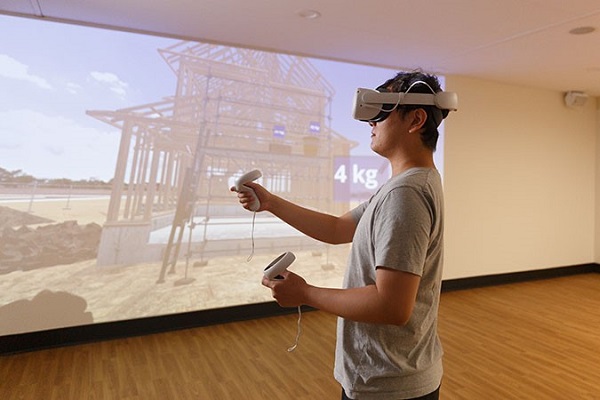Construction set to thrive in the digital age

University researchers are finding ways to boost construction safety with the help of virtual reality (VR) technology. San Williams finds out how it works.
Construction and VR are two fields of work that couldn’t seem further apart. However, as the number of worksite incidences for construction continues to roll on researchers at Victoria University (VU) have taken to VR and digital technology to save more lives and boost productivity.
Combining high-tech tools with engineering and architecture, VU’s head of building environment Professor Zora Vrcelj and head of IT Professor Yuan Miao have developed a VR technology they believe will take the construction industry to new heights.
“In the Construction Simulation (COSI) lab, construction trainees are provided with high-tech VR goggles and equipment to explore through the simulation and learn about on-site safety,” Zora says.
“Scenarios in the simulation range from working at slopy roofs, working on roofs, working in confined spaces, climbing ladders and climbing scaffolding. By replacing instruction booklets and outdated computer modules there will be a significant decrease in on-site incidents.”
The project was funded by the Victorian Higher Education State Investment Fund (VHESI), following what became the second deadliest sector for Australia’s construction industry in 2021.
With 1.26 million people, the building and construction industry has the highest proportion of apprentices or trainees compared to any other industry at nearly 10%.
“The building and construction industry, by its nature, is a dangerous workplace. The more training individuals can undertake, the safer they’ll be when they enter the workforce and when they work across different environments throughout the sector,” Builders Academy Australia Simonds Group (BAASG) chief executive officer Andrew O’Shea says.
“It’s so important to gain that understanding while minimising some of the logistical challenges as well as minimising the risk of the individual learning that capability.
“Rather than simply staring at a picture, to have that simulated experience in a virtual walkthrough makes a real difference in helping individuals learn and we think that will flow through to the building site and have a genuine positive impact.”
Being the fifth-highest earning Australian industry at $5.3 billion from 2020 to 2021, it’d be logical to assume construction to be leading the charge in digital innovation. However, this isn’t the case according to Zora who says construction is among the least digitised in the country.
She believes the VR simulator will help modernise the industry which is experiencing high rates of worksite injuries and a lack of quality control.
“Users of the technology can be anyone who is required to complete white card training including students, apprentices, construction practitioners and others,” Zora says.
“We have to bridge the gap and VR is the ideal platform to achieve that.”
In addition, Zora and Yuan are aiming to digitalise building surveying with a software platform and have already received the interest of government and construction organisations.
Hendry Group senior building surveyor Mark Filicieti says the technology would serve to better protect building surveyors in a vast and rapidly growing industry.
“The liability for building surveyors is continually increasing in the industry and if something changes after the inspection and that causes a noncompliance, we can be liable, even though it wasn’t there at the time we were on site,” Mark says.
The cloud-based platform allows building surveyors to remotely access uploaded photographs and 360° scans of buildings in real time from a smartphone or tablet.
Wyndham City Council municipal building surveyor Philip Wilson says the technology will bring property owners and builders greater peace of mind and more confidence in the house being constructed.
“In building a home, some of the tradies involved might cut holes in timber or install things that have an impact on the frame that’s not visible once the job is finished,” Philip says.
“The technology that VU are developing allows us to view it as it’s being built, right from the office… The footage is in the cloud so my staff can look at it any time they want. It brings a more thorough level of assessment and compliance so that the builders have confidence when they provide that warranty to the owner.”
Zora says the digital platform will also be a significantly cheaper alternative to current methods of building surveying which normally involves using a clipboard and a checklist during their assessment of the framework, electrics, plumbing and design.
“Our quality control tools are cost effective and custom designed for the construction industry in Victoria and Australia,” says Zora.
“The focus shifts from defect detection to prevention and, therefore, reduces the cost, the time of construction and also the waste as it removes the need to rectify faulty work.”
She also expects the COSI simulator to help address social challenges commonly faced in construction: “The construction industry employs only 2% of females in its workforce and this digital technology has a great capacity to open up the construction industry to diverse groups of people. It will leave the construction industry reputation to a whole new level.”
With VU’s digital VR and building surveying technologies seeming well on their way, Australian construction could soon expect a surge of advancement with various potential developments on the horizon.
“It opens the doors to those who may not choose building construction as a career initially and say ‘gee, that could well be for me’ and we believe it will make a genuine difference in educating individuals to reduce injuries and deaths on building sites,” Andrew says.
“I’m excited about the next stage of use for this kind of technology. I think it can increasingly make an impact on quality outcomes on-site and who knows what the next steps can be.”
